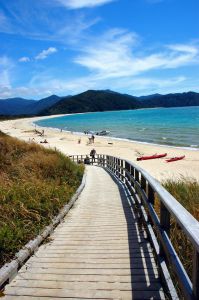 NIWA has published its climate outlook for the next three months:
NIWA has published its climate outlook for the next three months:
“Warmer than normal conditions likely to continue into autumn”
The equatorial Pacific remains in a strong La Niña state, which is expected to persist into the start of autumn 2011, says the NIWA National Climate Centre. Beyond this time, there is disagreement between the forecast models as to whether La Niña will continue into winter at a weaker level, or whether a transition to neutral conditions will occur.
Early autumn temperatures (February to April) are likely to be above average in all regions, except in the east of the both Islands where average or above average temperatures are equally likely.
Seasonal rainfall is likely to be normal or above normal in all North Island regions, and near normal in all South Island regions. Soil moisture levels and river flows during February-April are likely to be above normal in all North Island regions, normal or below normal on the east coast of the South Island, and near normal elsewhere in the South Island.
The seasonal outlook states that mean sea level pressures are likely to be below normal to the north of New Zealand, with weaker westerlies across the country.
Tropical cyclone activity is likely to be near- or above-normal this season (through to May 2011). The risk of an ex-tropical cyclone passing close to New Zealand is slightly above the long-term average. On average, at least one ex-tropical cyclone passes within 500km of New Zealand in 9 out of 10 cyclone seasons.
Overall Picture
Temperature:
On average for early autumn (February-April), temperatures are likely to be above average in all regions, except in the east of the North Island and the east of the South Island where average or above average temperatures are equally likely. Sea surface temperatures are presently slightly above normal around the North Island, and over the coming three months are expected to warm further above the normal for this time of year.
Rainfall, soil moisture, and river flows:
The National Climate Centre says that the expected lower pressures to the north of the country are likely to result in early autumn seasonal rainfall being normal or above normal across the North Island. Soil moisture levels and river flows are also likely to be above normal in all North Island regions. For the South Island, rainfall is likely to be near normal in all regions, whereas soil moisture levels and river flows are likely to be normal or below normal on the east coast of the South Island, and near normal elsewhere.
Regional predictions for the next three months:
Northland, Auckland, Waikato, Bay of Plenty:
Temperatures are likely to be above average. Seasonal rainfall totals over February-April are equally likely to be near normal or above normal. Soil moisture levels and river flows are likely to be above normal.
Central North Island, Taranaki, Wanganui, Manawatu and Wellington:
Temperatures are likely to be above average. Seasonal rainfall totals over February-April are equally likely to be either near normal or above normal, whereas soil moisture levels and river flows are likely to be above normal.
Gisborne, Hawke’s Bay, Wairarapa:
Temperatures are equally likely to be near average or above average. Seasonal rainfall totals are equally likely to be in the near normal or above normal range. Soil moisture levels and river flows are likely to be above normal.
Nelson, Marlborough, Buller:
Temperatures are likely to be in the above average range. Seasonal rainfall, soil moisture levels, and river flows are likely to be in the normal range.
West Coast, Alps and Foothills, Inland Otago, Southland:
Temperatures are very likely to be above average, for the three months as a whole. Seasonal rainfall, soil moisture levels, and river flows are likely to be in the normal range.
Coastal Canterbury, East Otago:
Temperatures are equally likely to be in the near average or above average range. Seasonal rainfalls are likely to be near normal, whereas soil moisture levels and river flows are equally likely to be in the near normal or below normal range.
Background
The tropical Pacific is in a strong La Niña state, which is likely to persist into early autumn 2011. Beyond that time, the evolution of the El Niño/La Niña cycle is uncertain. The present event has persisted since August 2010, and atmospheric indicators show this episode to be one of the strongest of the last 100 years. Previous very intense La Niña events occurred in 1975/76, 1971, and in 1917 (probably the strongest historically according to atmospheric indicators in the tropical Pacific).